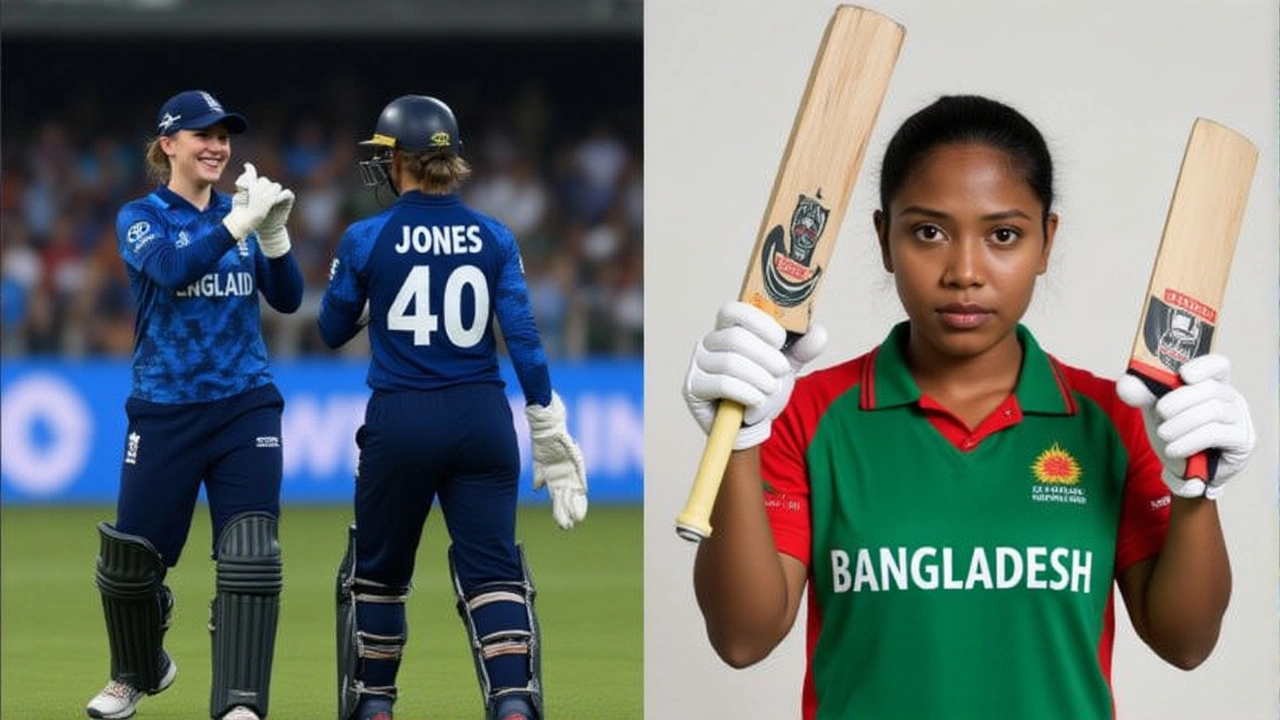When Nat Sciver-Brunt, captain of England Women's led her side to a four‑wicket win over Bangladesh Women's at Barsapara Cricket Stadium in Guwahati on Tuesday, October 7, 2025, the match also marked a decisive step in the ICC Women's World Cup 2025Guwahati, India. The win catapulted England to the top of Group A, a spot that suddenly feels both earned and precarious after a day of dramatic twists.
Match Overview: How the Game Unfolded
England won the toss and opted to bowl – a decision that surprised the pundits but made sense given the early‑morning conditions. Lauren Bell and Linsey Smith immediately put pressure on Bangladesh, skittling opener Rubya Haider and captain Nigar Sultana in consecutive power‑play overs. Those early wickets set the tone, but Bangladesh tried to claw back.
A 34‑run stand between Sharmin Akhter and Sobhana Mostary bought the innings a breath of stability. Akhter, however, could only muster 30 runs before falling in the 16th over. The middle order then sputtered: Shorna Akter managed a modest 10, Ritu Moni snuck in a painfully slow 5, and Fahima Khatun added just 7.
It was Sobhana Mostary who ultimately anchored the innings, grinding out 60 off 108 balls with eight fours. Yet the real fireworks came late: Rabeya Khan exploded for an unbeaten 43 off just 27 balls, rescuing Bangladesh from 85/3 and pushing the total to 178 before the last wicket fell in the 49.4th over.
Key Performances That Shifted Momentum
- Sobhana Mostary – 60 (108) – the innings’ backbone.
- Rabeya Khan – 43* (27) – a late‑order blitz that turned the chase into a realistic target.
- Lauren Bell – 2/31 – early breakthroughs that rattled Bangladesh’s top order.
- Linsey Smith – 2/28 – maintained pressure through the middle overs.
- Nat Sciver-Brunt – 45* (38) – guided England home with a calm finish.
England’s chase began shakily at 30/2, but the experienced duo of Amy Jones and Sciver‑Brunt steadied the ship. Jones, who had been in form with back‑to‑back 39 and 40‑not‑out scores, added a composed 31, while Sciver‑Brunt’s 45 off 38 deliveries ensured the target was chased with six balls to spare.
Tactical Decisions and Turning Points
Choosing to bowl first was a gamble, yet the early wickets proved the gamble paid off. England’s captain, Sciver‑Brunt, set aggressive fields that forced Bangladesh into a defensive mindset, limiting their scoring to 2.86 runs per over in the first 15 overs. The real turning point, however, was the partnership between Mostary and Khan; the latter’s 43‑run surge shifted the required run‑rate from a steep 5.5 to a manageable 4.2, changing the psychological landscape for both sides.
On the flip side, Bangladesh’s bowlers – especially Marufa Akter – had been tipped as potential match‑winners after a string of impressive figures (2/31 against Pakistan, 2/38 against Sri Lanka). Akter’s 2/37 on the day was decent but not enough to stem the English flow.
Reactions from Teams and Experts
Post‑match, Sciver‑Brunt praised her side’s resilience: “We knew the pitch would bite early, but we trusted our bowlers and kept our composure in the chase.” England’s head coach, Mark Boucher, added that the win “sets the tone for the rest of the tournament – we’re where we want to be.”
Bangladesh’s captain, Nigar Sultana, admitted disappointment but remained optimistic: “We gave ourselves a platform, especially Rabeya’s late fireworks. The experience will help us in the next games.” Analyst Simon Hughes noted, “If Bangladesh can fire up their middle order early, they could trouble any side. England still looks stronger on paper, but the gap is narrowing.”
Implications for the Tournament
With the win, England sits atop Group A with three points, edging past Australia and New Zealand, who both sit on two. Bangladesh, despite the loss, finishes with a respectable net‑run rate thanks to the respectable total of 178 – a figure that could prove pivotal if they win their next two matches.
The statistical contrast is stark: England’s batting average in the tournament now stands at 278 runs per innings, while Bangladesh’s lags at 246. Bowling-wise, England concedes an average of 5.36 runs per wicket compared with Bangladesh’s 5.63. Those margins, though slim, underline why England entered as the odds‑favorite.
Looking ahead, England will face India in their next group match on October 11, a clash that could decide the final semi‑final lineup. Bangladesh, meanwhile, has a crucial showdown against Sri Lanka on October 12, where a win would keep their hopes alive.
Key Facts
- Match: ICC Women’s World Cup 2025, Match 8
- Venue: Barsapara Cricket Stadium, Guwahati, India
- Result: England Women won by 4 wickets (target 179)
- Top scorer (Bangladesh): Sobhana Mostary – 60 runs
- Best bowler (England): Lauren Bell – 2/31
Frequently Asked Questions
How does this result affect England’s chances of reaching the semi‑finals?
The win puts England top of Group A with three points, giving them a one‑point cushion over Australia and New Zealand. If they maintain this form, they only need a single win against India to guarantee a semi‑final berth.
Which Bangladesh player showed the most promise despite the loss?
Rabeya Khan’s 43‑run blitz off 27 balls was a standout, demonstrating her ability to change a game in the death overs. Her strike rate of 159.3 suggests she could be a key finisher in the remaining group matches.
What were the decisive tactical moves by England’s captain?
Choosing to bowl first, setting aggressive early fields, and rotating strike in the chase were pivotal. Sciver‑Brunt’s decision to back her bowlers early paid dividends, and her measured batting partnership with Amy Jones steadied the chase after early wickets.
Could Bangladesh still qualify for the knockout stage?
Yes. With a solid net‑run rate from scoring 178 and a win in their next two fixtures, Bangladesh can finish second in the group, which would be enough to progress to the quarter‑finals under the tournament’s format.
What does this match tell us about the overall competitiveness of the tournament?
The close chase and Bangladesh’s late surge illustrate that the gap between the traditional powerhouses and emerging teams is narrowing. Expect more tightly contested matches as the group stage progresses, especially with a few teams still finding their rhythm.







Write a comment